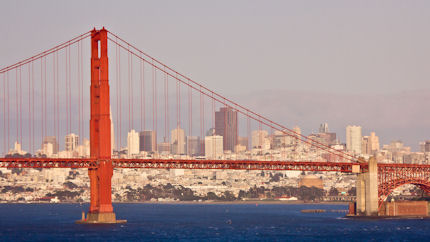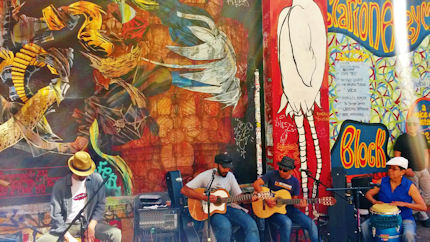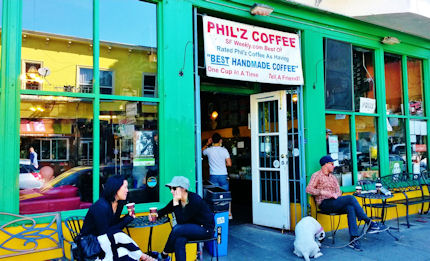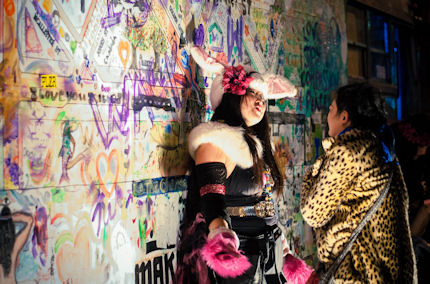Tech and San Francisco: CTRL, Alt, Delete?
We sent Lillian Marx to San Francisco, smartphone in hand, to see how technology is transforming the city and the tourism industry.
I order a pressed juice on my smartphone as the edges of San Francisco’s Chinatown and Little Italy blur outside the window.
But whatever the sleek wooden counters, leather barstools and table service suggest, I’m not at a trendy café. Instead, I’m on a Leap bus – a fleet of vehicles launched this month that run from San Francisco’s picturesque Marina to the Financial District.
I used the Leap app to purchase a $6 ticket and track down a ride. Now I’m plugged into a USB port, tapped into the free Wi-Fi and only vaguely aware of the onboard waiter handing a Blue Bottle coffee to the woman next to me.
An historic oasis for beat poets, Summer of Love hippies, immigrants, the gay rights movement, misfits, outcasts and artists, San Francisco is rapidly evolving again thanks to a new demographic: the ‘techie’.
The city has felt Silicon Valley reverberations since Google and Twitter opened offices downtown – and now start-ups are changing it quicker than it takes to download an app.
 San Francisco is rapidly evolving thanks to a new demographic: the ‘techie’
San Francisco is rapidly evolving thanks to a new demographic: the ‘techie’Creative Commons / Dan Kunz
“It’s almost like I see technological advancement as an end goal in itself,” says Xander Masotto, a local programmer. “I get this amazing joy whenever I write a code with observable effects.”
And this is what I’m here to explore: how technology is changing the tourist industry in San Francisco.
It’s now easier than ever to circumvent the sightseeing traps and get straight to the heart of local life. That’s down to programmes like the San Francisco Way app which sorts all the goings-on-about-town into categories. It helps me choose where to drink, but can also lead me to the nearest toilet.
With impeccable timing, it begins to drizzle as I step off the bus, just as the SF Microclimates app said it would. The hyper-local forecast app can predict the weather across different parts of the city.
I head past Twitter’s offices and into the Tenderloin neighbourhood, where trendy new condos, restaurants and bars are peppered between the district’s empty lots and shabby storefronts.
Gleaming among surviving hole-in-the-wall businesses, the brick-and-wood microbrewery Bar Mikkeller is full of customers keen to try one of its 42 tapped beers, which can come personally recommended by a certified cicerone.
But there are areas of the city where the union is more obvious. The neighbourhood that has really seduced the tech crowd is the Mission, a working-class Latino district that is as far from the Leap experience as you can get.
 Street musicians in the Mission
Street musicians in the MissionLillian Marx
I pass fathers chatting in Spanish by the escalators, while a guitarist strums a few chords, inaudible over the Catholic sermon that echoes through a tinny microphone next to him.
This is where Mark Zuckerberg owns a home. Its colourful, sweeping murals confirm the area as a mecca for artists, and colossal burritos are evidence of its unpretentious culinary scene.
But the affordability and gritty-cool that originally drew techies to the area now seem threatened by their arrival. Mexican bakery and coffee shop La Reyna still sports a bright mural of the Virgin Mary and serves sprinkled pastries at pennies a pop, but a block over, the clean interiors of Haus Coffee draw the laptop set with $6 chais and kombucha teas.
Like tech itself, the consequences of gentrification (both positive and negative) are playing out at high speed. Skyrocketing rent and increasing eviction rates have created tension between the city’s traditional residents and its newcomers.
Just last week, lease hikes pushed Jeffrey’s, a beloved local toy store, out of business after 45 years – this, in the affluent downtown shopping area. The wealth disparities in the Mission are starker still.
“The community within the [24th Street area] is witnessing rapid change,” District Supervisor, David Campos, says, “[it’s] a product of the affordability crisis that has overtaken San Francisco.”
Local activists have voiced similar concerns, prompting the city to inaugurate the ‘Calle 24 Latino Cultural District’. It is a symbolic recognition, but one Campos believes is necessary to prevent the neighbourhood from disappearing.
Not every Mission business has suffered, though.
Take Philz Coffee. Transformed in the early 2000s from corner grocery shop to café, Philz became a favourite haunt of tech workers. Investors soon stepped in and it opened a store at Facebook headquarters as part of a nationwide expansion.
 The original Philz Coffee on 24th Street
The original Philz Coffee on 24th StreetLillian Marx
In some ways, the culture at Philz is tech culture, but with different hardware: baristas personalise each coffee, helping the individual customer to choose a blend before adding milk and sweetener to taste.
This also manifests itself in the ‘sharing’ economy, where principles of peer-to-peer and on-demand exchange are the driving forces behind the stylishly efficient Leap buses. They fuel ubiquitous enterprises like Uber and Airbnb – two companies born in San Francisco.
The most natural participants in the ‘sharing’ system are members of the tech demographic: young, newly affluent workers who have been raised on values of innovation, personalisation and efficiency.
But visitors can get a taste of this lifestyle too. Already staying with Airbnb? Vayable connects you with a local for a niche tour of the city. Or sign up with Feastly for a meal at a private pop-up restaurant in someone’s house.
Not everyone is happy though.
“The cultural closeness that’s so uniquely San Francisco is gone, or disappearing,” says Bo Yan Moran, a native in her mid-twenties who has lived in the city her entire life.
She is waiting for the street car down the block from Outerlands restaurant and Trouble Coffee – two young establishments whose bustling hipster vibe stands out in the mostly residential Asian-American neighbourhood.
“Latinos in the Mission are getting kicked out,” she says, “Asians in the Sunset too. What happened to the accepting San Francisco that I grew up in? I feel like I don’t really have a city of my own anymore.”
So where should you head if you want to power down and talk to an actual person?
 Oakland: the city stepping out of San Fran's shadow
Oakland: the city stepping out of San Fran's shadowCreative Commons / Rafael Castillo
Some San Franciscans are finding refuge in Oakland, their neighbour across the Bay. One of the most culturally diverse cities in the US, Oakland is increasingly characterised as the ‘Brooklyn’ to San Francisco’s ‘Manhattan’.
It goes back to the days before Mission food trucks were cool and cheap, heaping portions of Mexican fare can still be had at Tacos los Michoacanos. Those searching for something more refined should try Nido, whose gorgeous plates don’t preclude a down-to-earth atmosphere.
Oakland’s contemporary arts are also thriving. The city’s Art Murmur is garnering significant attention with its gallery walks and cultural programming events, while the emigration of priced-out San Francisco artists simply contributes to the scene.
“Oakland has always had a rich and diverse culture, great food and amazing music,” Alison Best of Oakland’s tourism board tells me, “now the world is finally starting to take notice.”
And you don’t need an app to enjoy that.
Liked this? Then have a read of these:
Where to find the world's best coffee
Welcome to Britain's most radical city
Malaysia's street art revolution
Do you have any Feedback about this page?
© 2026 Columbus Travel Media Ltd. All rights reserved. No part of this site may be reproduced without our written permission, click here for information on Columbus Content Solutions.









 You know where
You know where